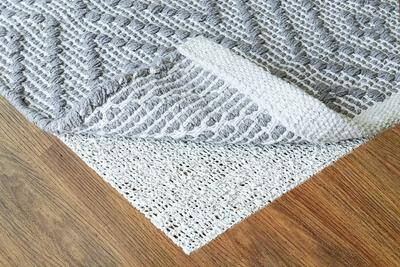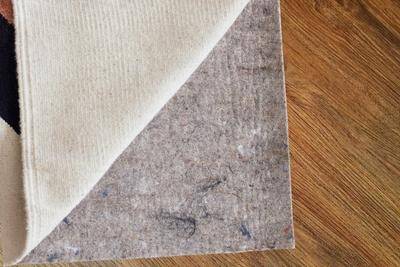TheRoundup is reader supported. We may earn a small commission when you make a purchase via links on this site, at no cost to you.
All products are personally reviewed and tested in accordance with our Review Methodology.

Are you looking for the best way to protect your flooring and keep your home environment healthy?
If so, did you know that the type of rug pad you choose can significantly affect how eco-friendly (and safe!) your home is?
Ever since a rug on a stone floor slipped from under me at a college dorm party, I’ve obsessed over securing my floor coverings.
However, not all rug pads are created equal. Some are made with toxic chemicals that can leach into your home and harm your family.
Read on to discover what my obsession uncovered as I test and review the best non-toxic rug pads available in the U.S.
Later in this article, I’ll explain what to look for when buying non-toxic and organic rug pads, and what to avoid.
But first, here are the eco-friendly rug pads that passed my tests with flying colors!

✔ Organic Jute Fibers
✔ Made in the USA
✔ 10-year warranty

They Say: A truly eco-friendly alternative to traditional non-slip pads, Nature’s Grip weds hand-woven organic jute fibers to natural rubber to maximize your rug’s grip, protect your flooring, and extend your rug’s life.
We Say: If you’re looking for a high-quality, eco-friendly rug pad that will provide a firm grip and keep your rug in place, look no further than RugPadUSA’s Nature’s Grip.
This pad is made in the U.S. from organic jute fibers and natural rubber, and it comes with a 10-year warranty.
What I love most about this rug pad is that it’s made from all-natural materials. The rubber is non-toxic and biodegradable, and the jute is a sustainable resource.
The low profile of this pad is perfect for door clearance or when you need a thin pad.
It’s also great for runners or scatter rugs. And because it’s made from natural materials, it’s safe for all floors and finishes (providing you follow the manufacturer’s instructions).
I’ve been using this rug pad in my office for a few weeks now, and I’m delighted with it.
It has a strong grip that holds my beloved Star Wars rugs in place in the middle of my office.
Cleaning this rug pad is also a breeze. Just wipe with a damp sponge or cloth and let dry. You might need a few drops of eco-friendly dish soap in your water for tougher stains.
Got a non-standard-sized rug and need a bespoke-sized rug pad? Not a problem! Let RugPadUSA know, and they’ll cut your new rug pad to whatever size you need.
I’m very impressed with RugPadUSA’s Nature’s Grip rug pad, and it gets the nod as my overall winner.
If you’re looking for an eco-friendly, durable, and effective rug pad, then I highly recommend giving it a try.

✔ Green Label Plus Certified
✔ Sustainably made in the USA
✔ Diverts landfill waste from carpet mills

They Say: Protect the lifespan of your rug with our Premium Rug Pad. The ultimate slip-stop design has a latex non-slip side that keeps the rug in place on all surfaces—even carpet—while providing a slight cushion underfoot. For decades to come, this pad will bring added comfort to your bedroom, all while extending the longevity of your favorite area rug.
We Say: Having already tested and recommended Boll & Branch for their non toxic comforter, mattress protectors, and GOTS certified sheets, I was excited (yes…I’m THAT much of a geek!) to see that they did a rug pad and was keen to put it through its paces.
I’m so glad I did. This excellent rug pad is made in the U.S. and is certified by Green Label Plus.
It’s also sustainably made with offcuts from carpet mills that would otherwise have found their way to landfill.
I’m impressed with this rug pad. But I also love how Boll & Branch is committed to sustainability.

✔ Eco-friendly Felt
✔ Natural rubber
✔ Made in the USA

They Say: To keep your rugs and floors lasting for years to come, we recommend adding a low-profile rug pad as a base layer to our designs. Made from felt with a solid, natural rubber backing, this rug pad provides strong gripping power to prevent slippage. Bonus: this rug pad is needle-punched, allowing your rug and floors to breathe while also preventing dirt and dust.
We Say: The Citizenry Eco-Friendly Rug Pad is also a great choice and a worthy joint runner-up.
There are plenty of size options available, so I’m sure you’ll find something to meet your needs:
I tested a 4’ Round rug pad under a round rug at our back door. It gets a lot of daily traffic (it’s the main route into the house for muddy boots and paws) and has not moved or slipped once!
This is an excellent rug pad. But I also love how The Citizenry approaches social impact issues.
A high-quality rug pad from a company with admirable eco-credentials. Win-win!

✔ Green Label Plus Certified
✔ Customizable Sizing
✔ Proudly made in the USA

They Say: Balancing long-lasting protection, and cushioned comfort, the Comfort Cushion Rug Pad by Mohawk Home will protect your area rug as well as the flooring beneath. Made of blended felt fibers, this sustainable rug pad with no latex backing is built to last, featuring added cushion to give your rug a softer feel underfoot. Our rug pads feature Green Label Plus Certification by The Carpet & Rug Institute, showcasing top-quality products with the lowest chemical emissions on the market.
We Say: We have a lovely old heirloom rug under our dinner table, and I’ve never really felt the need to use a pad under it because it’s firmly held in place by the table’s weight.
However, the testing process for this article was the perfect opportunity to test an unbacked pad to prolong the life of our faithful rug for another few decades.
And I’m so glad I did! It’s made it easier to vacuum up all the crumbs (thanks to the increased airflow).
This felt rug from Mohawk Home is an excellent quality product made in the U.S. It’s designed to protect your rug and flooring while adding comfort and cushioning.
The pad is made from recycled materials and is certified by the Carpet & Rug Institute as being of the highest quality and with the lowest chemical emissions.
I also love how customizable this rug pad is. Due to the lack of any backing, it’s easy to cut with scissors to fit any rug.
There are also three different thicknesses available:
And 14 different sizes:
If you’re looking for a high-quality, unbacked, American-made rug pad, look no further than Mohawk Home!
A rug pad is placed under a rug (a bit like underlay for carpet and flooring) to protect your flooring from the effects of hard-soled shoes and furniture, as well as provide insulation for cold climates and stability on slippery or hard floors.
I covered sustainably made rugs in a previous article. However, some readers who have hardwood floors reached out to me to ask about rug pads that are free from Volatile Organic Compounds (VOCs) and made from sustainable materials.
There's no point in having eco-friendly rugs but backing them with a pad that contains harmful materials! So that's why I decided to create this guide as well.
Most rug pads are made from synthetic padding material. These materials are often manufactured using harsh chemicals and heavy metals.
These materials can off-gas into your home for years. They also don’t biodegrade well and pose a health risk over time to both you and the environment.
If you have young children or pets, their health is especially at risk.
So if you’re looking for a way to create a healthier home environment, you’ll want to opt for non-toxic rug pads.
Synthetic latex and rubber are commonly used to make rug pads.
Synthetic latex is a petrochemical product containing phthalates and SBR (styrene-butadiene rubber), both suspected carcinogens.
Synthetic rubber is usually made from petrochemicals such as tar oils, primarily sourced from Malaysia or Cambodia. Environmental and human rights issues in the synthetic rubber industry concern me, including deforestation and chemical-heavy processing methods.
There is a health risk from chemicals used in rubber processing (such as chrome) leaching into water supplies.
You’ll also find foam and felt padding materials in many rug pads. These are better options than synthetic rubber or synthetic latex, but you still need to be aware of the source of these materials.
Foam padding is often made from recycled plastics and may contain toxic flame-retardant chemicals.
PVC (polyvinyl chloride) is also found in many traditional rug pads. PVC can also contain traces of phthalates.
Some commercial rug pads are made in factories that have never been inspected to ensure they don’t use toxic, harmful chemicals or hazardous and synthetic materials.
However, some manufacturers go above and beyond to get certification for their products. A good manufacturer can provide you with a copy of any certificates it has earned from credible third parties.
Some of the best certifications to look out for include:
Trusted third-party certifications give you the confidence that your product is as eco-friendly as it claims and helps you avoid falling for greenwashing tricks.
The pad you choose should be made from non-toxic materials and without the use of harsh or hazardous chemicals.
Some of the best non-toxic materials for rug pads include:
When looking at rug pads, you should be able to find a list of ingredients on the label or in the packaging that includes all raw materials used for construction.
Ask the manufacturer before purchasing their product if these are not clearly listed. And if they won’t tell you what’s in their pad, it’s probably not safe.
Some rug pads use a mix of latex and clay, which can dry out and flake off over time, causing potentially permanent damage to your floor if not taken care of properly.
Synthetic latex can stain hard floors.
If your flooring has a polyurethane finish [1], it might react with a PVC pad, causing it to stick to (and discolor) the flooring.
In my experience, you want a pad at least ¼” thick. This helps it provide cushioning for your rug and evenly distribute the weight of furniture on top to reduce any risk of damage to your floors.
Some manufacturers choose to build cheap, thin rug pads because it helps them cut costs.
However, when a pad is too thin, it won’t be able to protect your floor adequately and may not be durable enough.
This can lead to a situation where you’re buying replacement rug pads much more frequently than you would with a thicker pad.
Not all thin rug pads are terrible. But it’s something to be aware of if you’re looking for the best non-toxic option for your home.
Ultimately, the thickness of your rug pads is relative to the thickness of your rugs. If you have a thin rug, opt for a thinner pad. If you have a thick or heavy rug, select a thicker pad.
You get the best performance from your pad if it’s around 1” smaller than the rug on all sides.
This allows the pad to be hidden and not take away from the rug’s appearance.
If the pad is too large, it can look like an extra rug and become a trip hazard.
It might not serve its intended purpose well enough if it’s too small.
It depends on what it's made from. Some synthetic pads may contain chemicals that can damage or discolor hardwood floors.
That's another good reason to choose one made from organic materials - these are free from chemicals and flame retardants and therefore won't mark or damage your new hardwood floor.
Yes, rug pads can make your rug feel softer by helping to provide cushioning and reduce noise.
No, rug grippers are solely designed to help prevent your rug from slipping or moving around on a slippy stone, tile, or hardwood floor.
They’re not intended to provide cushioning or any of the other performance benefits of rug pads.
Ruggable is not a brand I tested for this article. However, I reached out to them, and they said, “The rug pad is made of polyester (95% recycled fiber). The Cling Effect™ texture is created by heating the surface (think Crème Brûlée dessert). The nonslip backing is made of Thermoplastic Resin (TPR), a latex-free synthetic material.”
According to RugPadUSA, “If you’re just looking for a non-slip grip, a simple fix to a runaway rug is to put a bead of silicone glue, hot glue, or caulking around the underside of the rug.”
Be careful, though, because if you’re planning on regularly moving the rug, the glue or caulk could damage both the rug and your floor. I would opt for rug grippers instead.
One of the best ways to reduce the volatile organic compound (VOC) and harmful chemical levels in your home is to ditch the wall-to-wall carpeting and use eco-friendly flooring instead.
However, some hard flooring options can feel cold and make your home unwelcoming.
Eco-friendly rugs are a great way to add warmth and a personal touch to your home. But don’t forget the non-toxic or organic rug pad to complement your non-toxic rugs.
When looking for non-toxic rug pads, it’s essential to be aware of the potential floor damage that can occur from certain materials used in their construction.
Selecting the right thickness and size for your specific rug is also crucial.
Do you use rug pads? Have I missed your favorite? Do you prefer sustainable options like organic cotton and jute? Or are you ok with the thought of having synthetic rubber or latex in your home?
Do you need further help selecting the best organic rug pads for your home? Drop me a line and let me know.

Our core values mean we always prioritize sustainability over profit. We carefully evaluate and personally test every product to ensure they meet our high standards. All products recommended in this article were tested in accordance with our Review Methodology.
TheRoundup.org - As Seen On
